 Facebook
Facebook
 X
X
 Instagram
Instagram
 TikTok
TikTok
 Youtube
Youtube
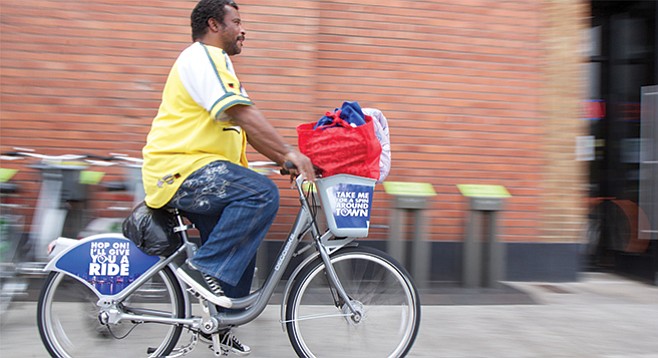
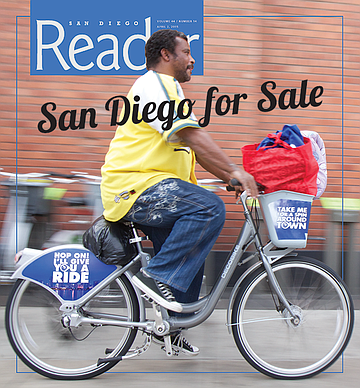
Dr. Ken Anderson, the affable owner of Pacific Beach’s Anderson Medical Clinic, has his hands folded, fingers interlaced, on his desk. He’s remembering the date, September 26, 2010. That day, the temperature over 100 degrees court side in Del Cerro, the humidity an untypical 78 percent, he and his wife were playing another couple at the Lake Murray Tennis Club. The two pairs were the only players at the club. In the middle of the third set, Anderson tells me, he went down: “I wasn’t breathing and I wasn’t moving.” His heart had stopped.
Neither his wife nor their friends had any medical training, though his friend’s wife did notice an automated external defibrillator near the front desk. She ran for the device, put it beside Anderson’s motionless body, and unzipped the canvas top. The machine started speaking. It told them to apply the panels to his chest. Then, in robot voice, “Shock advised. Stand clear. Press the orange button. Shock delivered. Start CPR.”

As a doctor, Anderson reminds me, he knows how perilous the moment was. “Had the defibrillator not been there I would not have made it.”
Such was Anderson’s great luck. But it wasn’t all luck. He was also saved by a coordinated effort (foresight, really) between the City of San Diego and a private donor. There was a reason that defibrillator was there, in the tennis club.
Twelve years ago, Bobbie Cohen and her husband Stuart were blissfully happy, attending their daughter’s wedding at a hotel in La Jolla. Stuart was dancing with the bride, telling her, “Life doesn’t get much better than this,” when his heart stopped and he collapsed. Someone called for a defibrillator. There was none — and he died before an ambulance arrived.
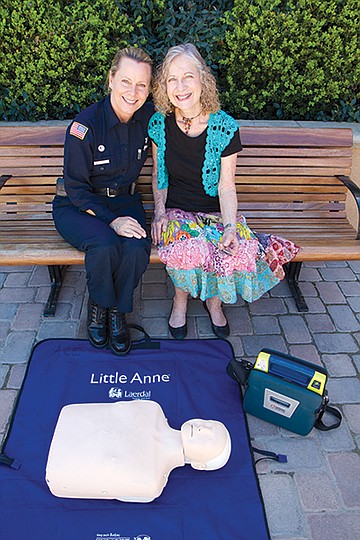
Cohen made it her mission to get defibrillators into San Diego’s public places — hotels, gyms, schools, tourist venues, churches, and more. One of the first places she installed a donated defibrillator was the Lake Murray Tennis Club. The supplier is Cardiac Sciences, which has a contract with the city and discounts units to departments and venues where people congregate. To date, more than 8000 defibrillators have been deployed in the county, administered by the fire department and the City’s Project Heartbeat. All because of advocates like Cohen and others, many of whom lost husbands to cardiac arrest, 126 people have been saved.
Were it the case that every public-private partnership had this sterling life-saving record, there’d be no worry that the city is marketing its assets for new revenue and in-kind donations. In the process, the city has developed a dizzying array and number of relationships with private companies, becoming, if you will, corporate-friendly, getting goods and services that it may otherwise not afford.
A once-broke city seeks partners
In 1999, the program for municipal marketing was born by a unanimous vote in the city council. The simple definition the city, a not-for-profit entity, adopted reads like a Craigslist personal: San Diego seeks relationships “with the corporate community to enhance municipal service and facilities in the city.”
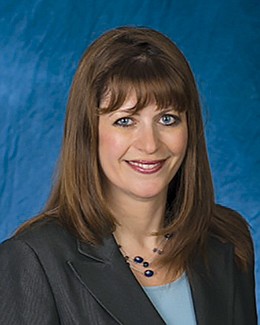
Though the idea is not new, municipal marketing didn’t ramp up — “skyrocket” is the term Natasha Collura, director of corporate partnerships and development, uses — until the 2008 recession forced government entities to look under every toadstool for new revenue. Collura worked for the San Diego Zoo for 12 years, overseeing corporate sponsorships and advertising, the top ad attractor, the Giant Panda program ($1 million a year from AT&T). Collura and her staff earned $7 million in “revenue and promotional in-kind value.”
Collura came to the city in 2011, where, by 2013, she was paddling upstream during mayor Bob Filner’s sewer-break. The city then “was under a bit of a cloud,” with potential clients “hesitant to get involved.” When he resigned, partners returned. At City Hall today, she tells me that in the past 15 years, the city has earned $25 million from partnership and sponsorship deals. Is this just a drop in the bucket of the city’s $2.8 billion annual budget? Collura sees it differently. “These are valuable programs that taxpayers don’t have to fund.”
For her office, there is Collura and a grant-writing assistant and the expectation to ink more partnerships every year. She writes in an e-mail, “We would like to have the problem of having too many sponsors and partners, but that is not the case.”
Navigating the language of partnerships — whose documents bristle with such business-speak as naming rights, branding, packaging, leveraging assets, and procurement — is not easy. Partnerships are “mutually beneficial business arrangements between the city and a company.” The company pays cash or in-kind services to create such arrangements.
Take the contract with life-saver Cardiac Science. Cash comes in from fees the company pays the city. The largest is the annual marketing fee of $145,000; other revenue includes finders’ fees, per-item sales stipends, and a promotional budget. The total over 11 years is $2.575 million, nearly 10 percent of Collura’s department’s intake. In exchange, the company gets to be the “Official AED Partner” (automated external defibrillator) of the city, its brand placed on promotional materials, its logo on three vehicles that administer the program, and a host of website links, ad rights, coverage at trade shows and health and safety events, and more.
It sounds like the city is making out on the deal. But if you look closely, some of this money goes to promote the defibrillators themselves on the city’s websites and materials. Some of the money pays the salaries of those in the city who oversee partnerships or promote the city’s interests. Collura notes the money does not all run “into the city’s revenue” stream. Cash from an agreement might be paid directly to the department that administers a program like fire and rescue.
The true value for Cardiac Science arises with its product exposure in those 8000 venues. It’s called in-kind value, and it’s tough to quantify. In an email, Collura writes that in-kind value is not calculated as cash. The “value of promotions is defined by the media value of radio, television or print; in-store exposure value; coupon redemptions as well as PR value.” Such pandemic access to San Diegans Cardiac Sciences could secure in no other way.
Collura — and the city’s guidelines — stipulate that partnerships are not advertising. “Advertising is the direct promotion of a company through space or air time bought for that specific purpose.” Ads are quantitative; sponsorships are qualitative. Yet, these programs are featured throughout the city’s reach, on signs, in community venues, on websites. Jane and Joe Citizen may not see these things as outright sponsorships but rather as clever ads.
What the city owns it also rents
In public spaces, we see a creeping kind of commercializing presence the city has sought. Whether from money donated to build the library or an ongoing sponsorship, it seems more public buildings than before get erected or city services maintain themselves via partnerships and naming-rights opportunities.
Take the downtown library. Its actual name is San Diego Central Library at Joan & Irwin Jacobs Common. Wander in and you’ll find the Denny Sanford Children’s Library, the Pauline Foster Teen Center, the Sanitas Health and Wellness Center. The last exemplifies partnering.
According to Charlie Goldberg of the library foundation, “Sanitas offers patrons free access to their subscription-based health research tool that provides valuable health information, particularly for those with chronic diseases.” Its computer software is part of the Wells Fargo Technology Learning Center.
As I say, there’s a dizzying array of sales, rentals, fees, and partnerships the city trucks in. Let’s take that truck literally. You want to have fireworks at your street fair, block party, parade, or film set. For your own good, you need a fire truck, crew, and permit. All are available from City Hall. According to the city’s fee schedule for 2014, a permit for a fire event costs $222.25; standby services (the truck), two-hour minimum, costs $110.90 per hour; add a fire inspector supervisor, an assistant fire marshal, a fire inspector II, and each ranges from $110.90 to $149.05 per hour.
Go down the list and you’ll find scores of things the city charges for: lifeguard services; library meeting rooms; library special events space; Mt. Hope Cemetery single gravesites, the opening or closing of graves, burial containers, memorial markers, upright monuments, and flower vases; athletic fields, gyms, outdoor courts, skate parks, and swimming pools; Balboa Park activity centers, recital halls, club and meeting rooms; Casa del Prado patios, dance studios, theaters, and auditoria; and the Spreckels Organ Pavilion. The outcall nude-entertainer business permit is $9219. The nude-entertainer establishment license is $5562. The card-room table fee is $3689. If you want to have a party with more than 400 people where alcohol is served, you need an entertainment permit, which’ll cost you $3970.
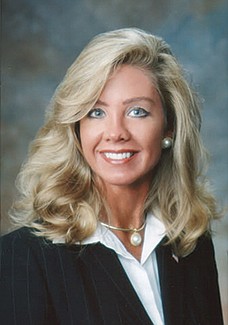
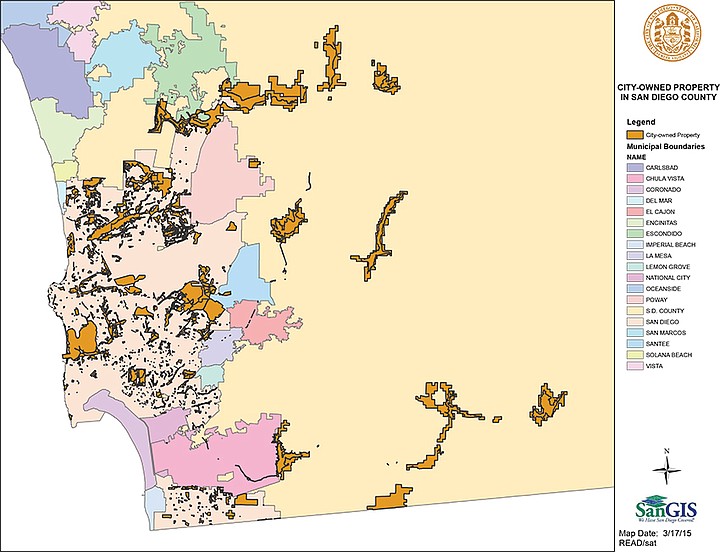
And then there’s city land-leases, some 500 of them. The city’s Real Estate Assets Department and its ancillary offices employs 60 people. It’s run by Cybele Thompson, a real property and facilities administrator who is also licensed to sell real estate. Thompson tells me by phone that “most of the land the city owns is not developed and cannot be developed or sold.” The city’s land — park and beachfront property cannot be sold without a vote of the people — includes the land under the Community Concourse; parking garages and lots at multiple venues, Qualcomm Stadium, Petco Park (70 percent city-owned, 30 percent Padres-owned), Balboa and Belmont parks; Montgomery and Brown fields; lake and watershed property; open-space preserves; and rights of way. city land may include buildings such as hotels in Mission Bay Park, which would also have leases. These leases generated $77 million in 2013.
Of the city’s 208,000 acres, the city owns 123,129 acres, or 58 percent, though “less than half of that land is suitable for lease,” Thompson says. Ground leases are long-term, she says, “in the 50-year range. No developer is going to spend the money it takes to build a Hilton Torrey Pines hotel, for example.” The Belmont Park lease runs to 2038.
Currently, Thompson’s department has one parking lot for sale. But that’s it. In fact, in the one year she’s been with the city, no large properties have been put on the block. Sometimes it’s just “leftover or random parcels.” This year, she says, “we’re developing a real estate portfolio of larger things we might sell.” Does the council want more revenue from our real estate holdings? “Every councilmember is interested in us maximizing the revenue on our land — sometimes that means selling, other times, ground-leasing it. Once we sell it, there’s no future income on it.”
City employees — target audience
Sprint Wireless has a corporate sponsorship agreement with the city, which replaced a ten-year partnership with Verizon. Sprint discounts plans to city employees via email blasts and lunch-time presentations. To get the right to do this, the company pays the city $275,000, in essence, buying access to municipal employees. Collura says that many employees welcome this deal because they save money on their personal phone plans. A sort of city perk, if you will.
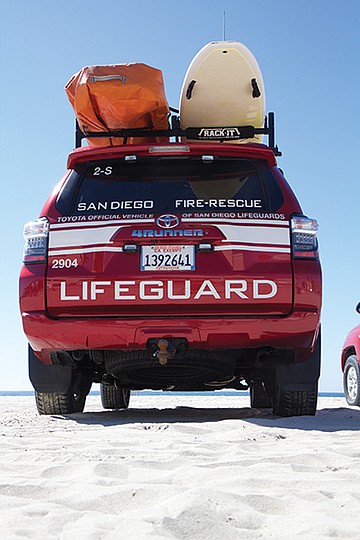
In the city’s strategic marketing and advertising plan, there’s a recurring boast that the one asset, which may “greatly increase the value of corporate partnerships,” is “the ability to market goods and/or services directly to city employees.” This “target audience” consists of 10,000 workers and 6,000 retirees. The group shares audience value with those ocean-using San Diegans and the 22 million annual visitors to our beaches, a fact that spurred Toyota to donate self-branded lifeguard vehicles.
To be sure, Collura says in an email, “we do not provide employee email addresses” or “utilize their work time” when they are pitched stuff by corporate sponsors.
Still, there’s a rising tide of employee products washing ashore. One such comes courtesy of San Diego Metropolitan Credit Union: low-cost tech loans; loans for energy-efficiency upgrades up to $25,000; a quarter percent off on vehicle loans; and free checks and checking. For that, Metropolitan gets preferred access to workers via sales pitches and eponymous ATM machines on city property. The name space — and its status as the city’s “Official Credit Union Partner” — drew Metropolitan and its winning bid.
The same is true for the DecoBike program. Ramping up this spring, some 1800 fee-based bikes will be available at 180 city locations. The company’s incentive to partner with the city is, as its website touts, to secure for itself “the most comprehensive network of outdoor advertising panels available in the city,” that is, ads on the bikes themselves, “which generate millions upon millions of impressions annually.” Rentable bikes will have a dominant presence wherever our urban commerce reigns: beaches, downtown, Balboa Park.
DecoBike co-founders Ricardo Pierdant and Bonifacio Diaz laud the bikes’ green value: accessed only via credit card, they will “improve mobility and the quality of life for everyone. Our program will create jobs, reduce air pollution and traffic congestion while moving people more efficiently around the city.” Moreover, DecoBike has pledged to “help complete the city’s transportation networks as a highly efficient first-mile, last-mile commuter program,” complementing existing buses and trollies.
Would the city have ponied up the money for such a bike-sharing program? No, Collura says. In fact, the plan began several years ago by mayor Jerry Sanders’s office. Since the city couldn’t afford to buy bikes and build and maintain bike stations, Sanders told the city council to find a company who’ll give us the bikes, manage the program, plus pay us for that right. Collura negotiated a deal with DecoBike.
In an ad-happy preview of things to come, DecoBike’s website showcases a bike advertising AMSTERDAM and KLM Airlines. Beginning this year, DecoBike will pay San Diego a total cash and in-kind value of $8 million for the next five years.
Conflicting Interests
Marketing private interests to the public stirs up conflicts of interest, a fact the city itself addresses. For example, take the contract the city has with Canteen Vending. Until 2011, Pepsi was the official soda of San Diego, paying us, over a 12-year sponsorship, $6.6 million for that right. Canteen Vending entered the fray with a contract that allows them to sell non-alcoholic beverages through vending machines at city facilities. This includes sports drinks, carbonated beverages, water, juice, teas, and coffee. The city gets 30 percent of the gross sales, with a minimum of $100,000 per year over five years.
The contract for snacks in self-serve machines is largely the same, with the city obtaining 20 percent of gross sales. But because children frequent the parks, snack-and-beverage contracts stipulate that 50 percent of the “food” in their machines has to be “healthy choices,” which the director of Parks and Recreation determines as follows: for each item, no trans fats, fewer than 250 calories, sodium less than 350 mg, and fat content less than 35 percent.
Tactics municipalities employ to get revenue may not exactly be quid pro quo but they can be close. Without stating the intent publicly, a city may defund a service, one far down the list of its priorities, so a corporate sponsor will rescue it. Case in point, in 2008, Chula Vista was about to close its Nature Center when Sempra Energy Foundation ponied up a $125,000 donation to help save it.
The idea of savings is another ploy. Often, one reads a statement like this: “The City of San Diego saved roughly $500,000 in vehicle leasing costs as a result of a partnership with Toyota Motor Sales, U.S.A.” Is this true? In other words, would the city not have spent this money to lease a fleet of lifeguard trucks?
Would the city not have bought defibrillators on its own? Hard to say. Maureen O’Connor — not the ex-mayor — is the program director of San Diego Project Heartbeat. O’Connor works for the city and administers a multi-pronged, donor-based partnership program. (Monetary donations go through the San Diego Foundation, an entity separate from the city, which, in turn, purchases and places defibrillators for nonprofit organizations, first-come, first-served.)
She tells me that, in 2000, city medical directors and fire chiefs, airport authorities, and county supervisors wanted to get defibrillators into government buildings. Apparently, city-council members and county supervisors hadn’t budgeted for these devices and welcomed the idea of a partnership to procure them. “It’s not required by fire departments,” O’Connor says. “And it does provide benefits to the corporate partner. No, the corporate sponsor did not come to us; we actually initiated this.”
She labels the result a win-win. San Diegans get the product donated and we save our tax dollars for other necessities. Mostly. There is an expense for select city workers to get the defibrillators, train staff to use them, market the partnerships, and maintain relationships via contracts and promotion.
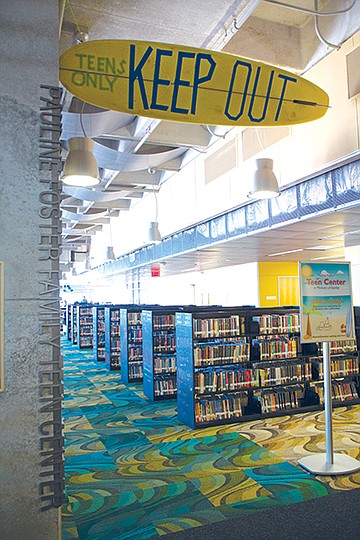
Still, one wonders, what is the future of muni-marketing? Precedence was set with the downtown library. Would the edifice have been built without the $68 million capital campaign as well as the myriad number of rooms and service with donors’ names? Probably not. If a new downtown football stadium is ever offered to the voters, will its naming rights along with the promise of new taxes from the developers and the property owners as well as service jobs at the venue be part of the sales scheme to win approval? Without a doubt. Sounds like a Yellow Brick Road we’ve been down before.
Most mass-attended venues are saturated with stuff somewhere between ads and sponsorships. Increasingly, it’s a reason not to go to stadia events or Padres games: the Jumbotron, the signage, the announcements, the noise. In baseball, the relief pitcher’s appearance has been sponsored by Rolaids, which, from 1976 to 2012, established and paid for the annual Rolaids Relief Man Award.
Not only is such ocular onslaught endemic to contemporary culture, but it comes with a price for the corporate sponsor. As we adapt to the ad-drench, we learn to ignore it. Collura cites the case of Coke, which recently sponsored a huge sporting event at a municipal venue in Los Angeles. The company plastered its red-and-white logo on every cup, dancing digital display, and banner available. Post-event, evaluators asked the masses who was the beverage sponsor? Only 40 percent identified Coke. Coke decided such ads were not cost-effective.
Coke’s withdrawal suggests people are disregarding — wittingly or unwittingly —the circus of sponsors. Hence, the sign-spinners: what does it take for the minions driving by to register our brand? The brand’s got to move! Still, San Diegans should take heart. Our sign ordinance is restrictive. We allow only 15 percent of a corporate and city co-sponsored message to identify the logo of the advertiser; Los Angeles County allows 40 percent.
Perceived endorsement
All this raises the specter of perceived endorsement, a phrase city document writers utilize to question the morality of marketing our town. On one hand, the city wants “to ensure,” as its guidelines state, “that sponsorship displays promote the economy, tourism and welfare of the city.” On the other hand, displays must limit “the size, duration, location and content” of partnerships. The city affirms that it will “coordinate, manage and protect” its public mediums “from over-commercialization, technology limitations or conflicts.”
Collura describes herself as “very sensitive” to the “perceived endorsement” of products whether it was with the San Diego Zoo, where she cut her teeth, or now with the city. At the zoo, she says there was pushback from scientists against sponsorship deals: “They didn’t understand why we needed to have marketing in the first place.” Her response, “To pay for the great work you’re doing in the field, we’ve got to have money. It was a healthy debate.”
What’s being debated is the question of what’s being sold. In large part, it’s San Diego’s good name, because it’s associated with sublime weather, proximity to the Pacific Rim, and Mexico — a thriving, sports-hungry, physical culture. It’s a good thing to be associated with the good name of San Diego. What’s more, the city self-identifies as environmentally conscious by means of its ride-sharing opportunities, electric-vehicle promotion and charging stations, recycling programs, bike-sharing, and so on.
I asked Robert Wechsler of CityEthics.org how much a city should be marketing itself. When you talk about endorsements, he tells me by phone from his office in Connecticut, “you’re talking about individuals: a mayor endorsing a company, for instance.” But when the city itself starts “talking about a product or company in a commercial way, a lot of city ethics’ codes forbid that.” Municipalities “are selling access,” he continues, “and it’s special access which nobody else has. On the other hand, [such sales] may be representing the community if there are guidelines and a bid process.”
Stacey Fulhorst, executive director of the San Diego Ethics Commission, writes in an email that for muni-marketing the commission “does not have ethical guidelines, nor do we have any rules specific to any one city department. We administer the City’s Ethics Ordinance, which addresses the financial interests of city officials; e.g., the disclosure of personal financial interests, the acceptance of gifts, and the prohibition on using your official position to enhance your own personal financial interests.” Such rules apply to individuals, not departments or programs.
Wechsler says that people tend to recognize the difference between ads, like those in a city subway system, and sponsorships like Toyota beach vehicles. “It’s when you get sponsors putting logos on school buses, then people will question it. If it’s tied to children.” He says fuzzy borders between ads and sponsorships can “be problematic but they don’t happen that much for that reason.”
In a review of What Money Can’t Buy: The Moral Limits of Markets, by Michael Sandel, Wechsler writes that “a market approach to government” is inappropriate because it “places a monetary value on [the] goods” a city delivers, namely, its services. “Public goods are shared or distributed on the basis of need.”
Wechsler adds, “When people say, ‘Oh, government is just like a business,’ I say, ‘Actually it isn’t. It doesn’t have shareholders and customers. It has citizens.’”



Dr. Ken Anderson, the affable owner of Pacific Beach’s Anderson Medical Clinic, has his hands folded, fingers interlaced, on his desk. He’s remembering the date, September 26, 2010. That day, the temperature over 100 degrees court side in Del Cerro, the humidity an untypical 78 percent, he and his wife were playing another couple at the Lake Murray Tennis Club. The two pairs were the only players at the club. In the middle of the third set, Anderson tells me, he went down: “I wasn’t breathing and I wasn’t moving.” His heart had stopped.
Neither his wife nor their friends had any medical training, though his friend’s wife did notice an automated external defibrillator near the front desk. She ran for the device, put it beside Anderson’s motionless body, and unzipped the canvas top. The machine started speaking. It told them to apply the panels to his chest. Then, in robot voice, “Shock advised. Stand clear. Press the orange button. Shock delivered. Start CPR.”

As a doctor, Anderson reminds me, he knows how perilous the moment was. “Had the defibrillator not been there I would not have made it.”
Such was Anderson’s great luck. But it wasn’t all luck. He was also saved by a coordinated effort (foresight, really) between the City of San Diego and a private donor. There was a reason that defibrillator was there, in the tennis club.
Twelve years ago, Bobbie Cohen and her husband Stuart were blissfully happy, attending their daughter’s wedding at a hotel in La Jolla. Stuart was dancing with the bride, telling her, “Life doesn’t get much better than this,” when his heart stopped and he collapsed. Someone called for a defibrillator. There was none — and he died before an ambulance arrived.

Cohen made it her mission to get defibrillators into San Diego’s public places — hotels, gyms, schools, tourist venues, churches, and more. One of the first places she installed a donated defibrillator was the Lake Murray Tennis Club. The supplier is Cardiac Sciences, which has a contract with the city and discounts units to departments and venues where people congregate. To date, more than 8000 defibrillators have been deployed in the county, administered by the fire department and the City’s Project Heartbeat. All because of advocates like Cohen and others, many of whom lost husbands to cardiac arrest, 126 people have been saved.
Were it the case that every public-private partnership had this sterling life-saving record, there’d be no worry that the city is marketing its assets for new revenue and in-kind donations. In the process, the city has developed a dizzying array and number of relationships with private companies, becoming, if you will, corporate-friendly, getting goods and services that it may otherwise not afford.
A once-broke city seeks partners
In 1999, the program for municipal marketing was born by a unanimous vote in the city council. The simple definition the city, a not-for-profit entity, adopted reads like a Craigslist personal: San Diego seeks relationships “with the corporate community to enhance municipal service and facilities in the city.”

Though the idea is not new, municipal marketing didn’t ramp up — “skyrocket” is the term Natasha Collura, director of corporate partnerships and development, uses — until the 2008 recession forced government entities to look under every toadstool for new revenue. Collura worked for the San Diego Zoo for 12 years, overseeing corporate sponsorships and advertising, the top ad attractor, the Giant Panda program ($1 million a year from AT&T). Collura and her staff earned $7 million in “revenue and promotional in-kind value.”
Collura came to the city in 2011, where, by 2013, she was paddling upstream during mayor Bob Filner’s sewer-break. The city then “was under a bit of a cloud,” with potential clients “hesitant to get involved.” When he resigned, partners returned. At City Hall today, she tells me that in the past 15 years, the city has earned $25 million from partnership and sponsorship deals. Is this just a drop in the bucket of the city’s $2.8 billion annual budget? Collura sees it differently. “These are valuable programs that taxpayers don’t have to fund.”
For her office, there is Collura and a grant-writing assistant and the expectation to ink more partnerships every year. She writes in an e-mail, “We would like to have the problem of having too many sponsors and partners, but that is not the case.”
Navigating the language of partnerships — whose documents bristle with such business-speak as naming rights, branding, packaging, leveraging assets, and procurement — is not easy. Partnerships are “mutually beneficial business arrangements between the city and a company.” The company pays cash or in-kind services to create such arrangements.
Take the contract with life-saver Cardiac Science. Cash comes in from fees the company pays the city. The largest is the annual marketing fee of $145,000; other revenue includes finders’ fees, per-item sales stipends, and a promotional budget. The total over 11 years is $2.575 million, nearly 10 percent of Collura’s department’s intake. In exchange, the company gets to be the “Official AED Partner” (automated external defibrillator) of the city, its brand placed on promotional materials, its logo on three vehicles that administer the program, and a host of website links, ad rights, coverage at trade shows and health and safety events, and more.
It sounds like the city is making out on the deal. But if you look closely, some of this money goes to promote the defibrillators themselves on the city’s websites and materials. Some of the money pays the salaries of those in the city who oversee partnerships or promote the city’s interests. Collura notes the money does not all run “into the city’s revenue” stream. Cash from an agreement might be paid directly to the department that administers a program like fire and rescue.
The true value for Cardiac Science arises with its product exposure in those 8000 venues. It’s called in-kind value, and it’s tough to quantify. In an email, Collura writes that in-kind value is not calculated as cash. The “value of promotions is defined by the media value of radio, television or print; in-store exposure value; coupon redemptions as well as PR value.” Such pandemic access to San Diegans Cardiac Sciences could secure in no other way.
Collura — and the city’s guidelines — stipulate that partnerships are not advertising. “Advertising is the direct promotion of a company through space or air time bought for that specific purpose.” Ads are quantitative; sponsorships are qualitative. Yet, these programs are featured throughout the city’s reach, on signs, in community venues, on websites. Jane and Joe Citizen may not see these things as outright sponsorships but rather as clever ads.
What the city owns it also rents
In public spaces, we see a creeping kind of commercializing presence the city has sought. Whether from money donated to build the library or an ongoing sponsorship, it seems more public buildings than before get erected or city services maintain themselves via partnerships and naming-rights opportunities.
Take the downtown library. Its actual name is San Diego Central Library at Joan & Irwin Jacobs Common. Wander in and you’ll find the Denny Sanford Children’s Library, the Pauline Foster Teen Center, the Sanitas Health and Wellness Center. The last exemplifies partnering.
According to Charlie Goldberg of the library foundation, “Sanitas offers patrons free access to their subscription-based health research tool that provides valuable health information, particularly for those with chronic diseases.” Its computer software is part of the Wells Fargo Technology Learning Center.
As I say, there’s a dizzying array of sales, rentals, fees, and partnerships the city trucks in. Let’s take that truck literally. You want to have fireworks at your street fair, block party, parade, or film set. For your own good, you need a fire truck, crew, and permit. All are available from City Hall. According to the city’s fee schedule for 2014, a permit for a fire event costs $222.25; standby services (the truck), two-hour minimum, costs $110.90 per hour; add a fire inspector supervisor, an assistant fire marshal, a fire inspector II, and each ranges from $110.90 to $149.05 per hour.
Go down the list and you’ll find scores of things the city charges for: lifeguard services; library meeting rooms; library special events space; Mt. Hope Cemetery single gravesites, the opening or closing of graves, burial containers, memorial markers, upright monuments, and flower vases; athletic fields, gyms, outdoor courts, skate parks, and swimming pools; Balboa Park activity centers, recital halls, club and meeting rooms; Casa del Prado patios, dance studios, theaters, and auditoria; and the Spreckels Organ Pavilion. The outcall nude-entertainer business permit is $9219. The nude-entertainer establishment license is $5562. The card-room table fee is $3689. If you want to have a party with more than 400 people where alcohol is served, you need an entertainment permit, which’ll cost you $3970.


And then there’s city land-leases, some 500 of them. The city’s Real Estate Assets Department and its ancillary offices employs 60 people. It’s run by Cybele Thompson, a real property and facilities administrator who is also licensed to sell real estate. Thompson tells me by phone that “most of the land the city owns is not developed and cannot be developed or sold.” The city’s land — park and beachfront property cannot be sold without a vote of the people — includes the land under the Community Concourse; parking garages and lots at multiple venues, Qualcomm Stadium, Petco Park (70 percent city-owned, 30 percent Padres-owned), Balboa and Belmont parks; Montgomery and Brown fields; lake and watershed property; open-space preserves; and rights of way. city land may include buildings such as hotels in Mission Bay Park, which would also have leases. These leases generated $77 million in 2013.
Of the city’s 208,000 acres, the city owns 123,129 acres, or 58 percent, though “less than half of that land is suitable for lease,” Thompson says. Ground leases are long-term, she says, “in the 50-year range. No developer is going to spend the money it takes to build a Hilton Torrey Pines hotel, for example.” The Belmont Park lease runs to 2038.
Currently, Thompson’s department has one parking lot for sale. But that’s it. In fact, in the one year she’s been with the city, no large properties have been put on the block. Sometimes it’s just “leftover or random parcels.” This year, she says, “we’re developing a real estate portfolio of larger things we might sell.” Does the council want more revenue from our real estate holdings? “Every councilmember is interested in us maximizing the revenue on our land — sometimes that means selling, other times, ground-leasing it. Once we sell it, there’s no future income on it.”
City employees — target audience
Sprint Wireless has a corporate sponsorship agreement with the city, which replaced a ten-year partnership with Verizon. Sprint discounts plans to city employees via email blasts and lunch-time presentations. To get the right to do this, the company pays the city $275,000, in essence, buying access to municipal employees. Collura says that many employees welcome this deal because they save money on their personal phone plans. A sort of city perk, if you will.

In the city’s strategic marketing and advertising plan, there’s a recurring boast that the one asset, which may “greatly increase the value of corporate partnerships,” is “the ability to market goods and/or services directly to city employees.” This “target audience” consists of 10,000 workers and 6,000 retirees. The group shares audience value with those ocean-using San Diegans and the 22 million annual visitors to our beaches, a fact that spurred Toyota to donate self-branded lifeguard vehicles.
To be sure, Collura says in an email, “we do not provide employee email addresses” or “utilize their work time” when they are pitched stuff by corporate sponsors.
Still, there’s a rising tide of employee products washing ashore. One such comes courtesy of San Diego Metropolitan Credit Union: low-cost tech loans; loans for energy-efficiency upgrades up to $25,000; a quarter percent off on vehicle loans; and free checks and checking. For that, Metropolitan gets preferred access to workers via sales pitches and eponymous ATM machines on city property. The name space — and its status as the city’s “Official Credit Union Partner” — drew Metropolitan and its winning bid.
The same is true for the DecoBike program. Ramping up this spring, some 1800 fee-based bikes will be available at 180 city locations. The company’s incentive to partner with the city is, as its website touts, to secure for itself “the most comprehensive network of outdoor advertising panels available in the city,” that is, ads on the bikes themselves, “which generate millions upon millions of impressions annually.” Rentable bikes will have a dominant presence wherever our urban commerce reigns: beaches, downtown, Balboa Park.
DecoBike co-founders Ricardo Pierdant and Bonifacio Diaz laud the bikes’ green value: accessed only via credit card, they will “improve mobility and the quality of life for everyone. Our program will create jobs, reduce air pollution and traffic congestion while moving people more efficiently around the city.” Moreover, DecoBike has pledged to “help complete the city’s transportation networks as a highly efficient first-mile, last-mile commuter program,” complementing existing buses and trollies.
Would the city have ponied up the money for such a bike-sharing program? No, Collura says. In fact, the plan began several years ago by mayor Jerry Sanders’s office. Since the city couldn’t afford to buy bikes and build and maintain bike stations, Sanders told the city council to find a company who’ll give us the bikes, manage the program, plus pay us for that right. Collura negotiated a deal with DecoBike.
In an ad-happy preview of things to come, DecoBike’s website showcases a bike advertising AMSTERDAM and KLM Airlines. Beginning this year, DecoBike will pay San Diego a total cash and in-kind value of $8 million for the next five years.
Conflicting Interests
Marketing private interests to the public stirs up conflicts of interest, a fact the city itself addresses. For example, take the contract the city has with Canteen Vending. Until 2011, Pepsi was the official soda of San Diego, paying us, over a 12-year sponsorship, $6.6 million for that right. Canteen Vending entered the fray with a contract that allows them to sell non-alcoholic beverages through vending machines at city facilities. This includes sports drinks, carbonated beverages, water, juice, teas, and coffee. The city gets 30 percent of the gross sales, with a minimum of $100,000 per year over five years.
The contract for snacks in self-serve machines is largely the same, with the city obtaining 20 percent of gross sales. But because children frequent the parks, snack-and-beverage contracts stipulate that 50 percent of the “food” in their machines has to be “healthy choices,” which the director of Parks and Recreation determines as follows: for each item, no trans fats, fewer than 250 calories, sodium less than 350 mg, and fat content less than 35 percent.
Tactics municipalities employ to get revenue may not exactly be quid pro quo but they can be close. Without stating the intent publicly, a city may defund a service, one far down the list of its priorities, so a corporate sponsor will rescue it. Case in point, in 2008, Chula Vista was about to close its Nature Center when Sempra Energy Foundation ponied up a $125,000 donation to help save it.
The idea of savings is another ploy. Often, one reads a statement like this: “The City of San Diego saved roughly $500,000 in vehicle leasing costs as a result of a partnership with Toyota Motor Sales, U.S.A.” Is this true? In other words, would the city not have spent this money to lease a fleet of lifeguard trucks?
Would the city not have bought defibrillators on its own? Hard to say. Maureen O’Connor — not the ex-mayor — is the program director of San Diego Project Heartbeat. O’Connor works for the city and administers a multi-pronged, donor-based partnership program. (Monetary donations go through the San Diego Foundation, an entity separate from the city, which, in turn, purchases and places defibrillators for nonprofit organizations, first-come, first-served.)
She tells me that, in 2000, city medical directors and fire chiefs, airport authorities, and county supervisors wanted to get defibrillators into government buildings. Apparently, city-council members and county supervisors hadn’t budgeted for these devices and welcomed the idea of a partnership to procure them. “It’s not required by fire departments,” O’Connor says. “And it does provide benefits to the corporate partner. No, the corporate sponsor did not come to us; we actually initiated this.”
She labels the result a win-win. San Diegans get the product donated and we save our tax dollars for other necessities. Mostly. There is an expense for select city workers to get the defibrillators, train staff to use them, market the partnerships, and maintain relationships via contracts and promotion.

Still, one wonders, what is the future of muni-marketing? Precedence was set with the downtown library. Would the edifice have been built without the $68 million capital campaign as well as the myriad number of rooms and service with donors’ names? Probably not. If a new downtown football stadium is ever offered to the voters, will its naming rights along with the promise of new taxes from the developers and the property owners as well as service jobs at the venue be part of the sales scheme to win approval? Without a doubt. Sounds like a Yellow Brick Road we’ve been down before.
Most mass-attended venues are saturated with stuff somewhere between ads and sponsorships. Increasingly, it’s a reason not to go to stadia events or Padres games: the Jumbotron, the signage, the announcements, the noise. In baseball, the relief pitcher’s appearance has been sponsored by Rolaids, which, from 1976 to 2012, established and paid for the annual Rolaids Relief Man Award.
Not only is such ocular onslaught endemic to contemporary culture, but it comes with a price for the corporate sponsor. As we adapt to the ad-drench, we learn to ignore it. Collura cites the case of Coke, which recently sponsored a huge sporting event at a municipal venue in Los Angeles. The company plastered its red-and-white logo on every cup, dancing digital display, and banner available. Post-event, evaluators asked the masses who was the beverage sponsor? Only 40 percent identified Coke. Coke decided such ads were not cost-effective.
Coke’s withdrawal suggests people are disregarding — wittingly or unwittingly —the circus of sponsors. Hence, the sign-spinners: what does it take for the minions driving by to register our brand? The brand’s got to move! Still, San Diegans should take heart. Our sign ordinance is restrictive. We allow only 15 percent of a corporate and city co-sponsored message to identify the logo of the advertiser; Los Angeles County allows 40 percent.
Perceived endorsement
All this raises the specter of perceived endorsement, a phrase city document writers utilize to question the morality of marketing our town. On one hand, the city wants “to ensure,” as its guidelines state, “that sponsorship displays promote the economy, tourism and welfare of the city.” On the other hand, displays must limit “the size, duration, location and content” of partnerships. The city affirms that it will “coordinate, manage and protect” its public mediums “from over-commercialization, technology limitations or conflicts.”
Collura describes herself as “very sensitive” to the “perceived endorsement” of products whether it was with the San Diego Zoo, where she cut her teeth, or now with the city. At the zoo, she says there was pushback from scientists against sponsorship deals: “They didn’t understand why we needed to have marketing in the first place.” Her response, “To pay for the great work you’re doing in the field, we’ve got to have money. It was a healthy debate.”
What’s being debated is the question of what’s being sold. In large part, it’s San Diego’s good name, because it’s associated with sublime weather, proximity to the Pacific Rim, and Mexico — a thriving, sports-hungry, physical culture. It’s a good thing to be associated with the good name of San Diego. What’s more, the city self-identifies as environmentally conscious by means of its ride-sharing opportunities, electric-vehicle promotion and charging stations, recycling programs, bike-sharing, and so on.
I asked Robert Wechsler of CityEthics.org how much a city should be marketing itself. When you talk about endorsements, he tells me by phone from his office in Connecticut, “you’re talking about individuals: a mayor endorsing a company, for instance.” But when the city itself starts “talking about a product or company in a commercial way, a lot of city ethics’ codes forbid that.” Municipalities “are selling access,” he continues, “and it’s special access which nobody else has. On the other hand, [such sales] may be representing the community if there are guidelines and a bid process.”
Stacey Fulhorst, executive director of the San Diego Ethics Commission, writes in an email that for muni-marketing the commission “does not have ethical guidelines, nor do we have any rules specific to any one city department. We administer the City’s Ethics Ordinance, which addresses the financial interests of city officials; e.g., the disclosure of personal financial interests, the acceptance of gifts, and the prohibition on using your official position to enhance your own personal financial interests.” Such rules apply to individuals, not departments or programs.
Wechsler says that people tend to recognize the difference between ads, like those in a city subway system, and sponsorships like Toyota beach vehicles. “It’s when you get sponsors putting logos on school buses, then people will question it. If it’s tied to children.” He says fuzzy borders between ads and sponsorships can “be problematic but they don’t happen that much for that reason.”
In a review of What Money Can’t Buy: The Moral Limits of Markets, by Michael Sandel, Wechsler writes that “a market approach to government” is inappropriate because it “places a monetary value on [the] goods” a city delivers, namely, its services. “Public goods are shared or distributed on the basis of need.”
Wechsler adds, “When people say, ‘Oh, government is just like a business,’ I say, ‘Actually it isn’t. It doesn’t have shareholders and customers. It has citizens.’”
Comments